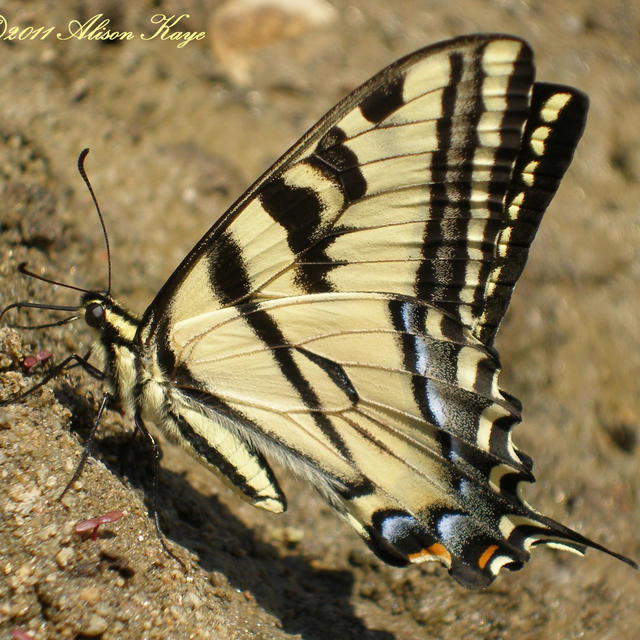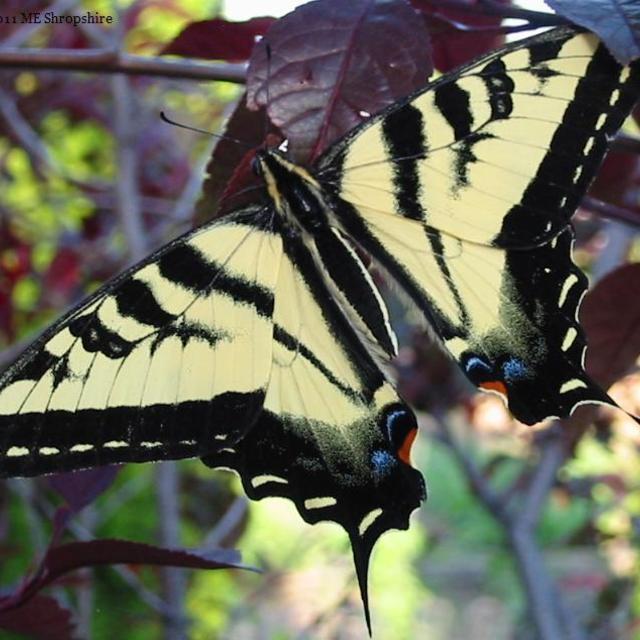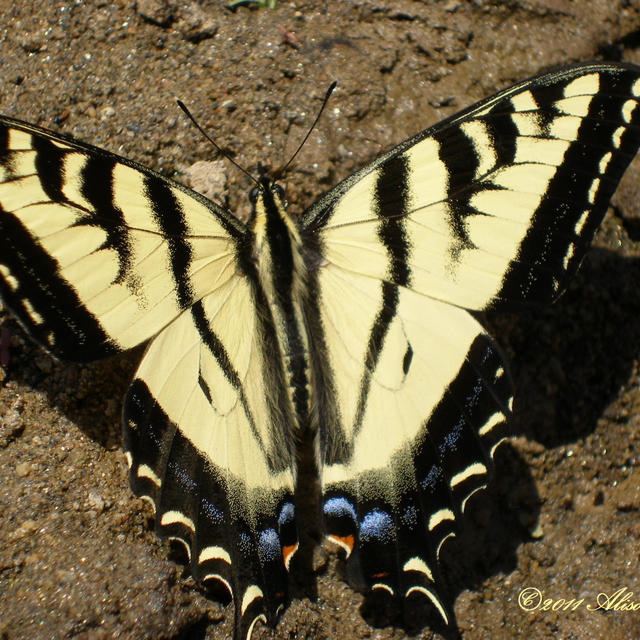Western Tiger Swallowtail
Papilio rutulus Lucas, 1852
Family: Papilionidae
Subfamily: Papilioninae
Identification: Upperside of hindwing with upper-most marginal spot yellow or lacking. Underside of forewing with separate yellow spots forming marginal band. Hindwing has narrow marginal spots and no orange tint except for 2 spots near end of inner margin.
Wing Span: 2 3/4 - 4 inches (7 - 10 cm).
Life History: Males patrol canyons or hilltops for receptive females. Females lay eggs singly on surface of host plant leaves. Caterpillars feed on leaves and rest on silken mats in shelters of curled leaves. Chrysalids hibernate.
Flight: One flight from June-July.
Caterpillar Hosts: Leaves of cottonwood and aspen (Populus), willows (Salix), wild cherry (Prunus), and ash (Fraxinus).
Adult Food: Nectar from many flowers including thistles, abelia, California buckeye, zinnia, and yerba santa.
Habitat: Woodlands near rivers and streams, wooded suburbs, canyons, parks, roadsides, and oases.
Range: Western North America from British Columbia south to southern New Mexico and Baja California; east to western South Dakota and southeast Colorado. A rare stray to central Nebraska.
Conservation: Not usually required.
NCGR: G5 - Demonstrably secure globally, though it may be quite rare in parts of its range, especially at the periphery.
Management Needs: None noted.
Get your BAMONA Gear!
Please donate!
We depend on donations to keep Butterflies and Moths of North America freely available. We want to express our gratitude to all who showed their support by making a contribution this year. You can donate to support this project at any time.
Advertise with us!
Do you have a product or service that you think would interest BAMONA users? If you would like to advertise on this website, contact us by email, or use the contact form and select the "Advertising" category.
Verified Sightings
Displaying 121 - 144 of 1277 verified sightings

Observation date: Aug 05, 2022
Submitted by: Karen Richardson
Region: Sacramento County, California, United States
Verified by: Ken Davenport
Verified date: Aug 06, 2022

Observation date: Jul 14, 2022
Submitted by: Davi
Region: Washington County, Oregon, United States
Verified by: Ken Davenport
Verified date: Aug 02, 2022

Observation date: Jul 30, 2022
Submitted by: NikkiM
Region: Carbon County, Montana, United States
Verified by: J_Martineau
Verified date: Aug 02, 2022

Observation date: Jul 27, 2022
Submitted by: MAKI
Region: Siskiyou County, California, United States
Verified by: Ken Davenport
Verified date: Aug 01, 2022

Observation date: Jul 23, 2022
Submitted by: XcileraTing
Region: Lincoln County, Washington, United States
Verified by: davidwdroppers
Verified date: Jul 29, 2022

Observation date: Jul 28, 2022
Submitted by: Steve Koehler
Region: Clallam County, Washington, United States
Verified by: davidwdroppers
Verified date: Jul 29, 2022

Observation date: Jul 20, 2022
Submitted by: Seth Mueller
Region: Mono County, California, United States
Verified by: Ken Davenport
Verified date: Jul 25, 2022

Observation date: Jul 20, 2022
Submitted by: Logan Miederhoff
Region: Mono County, California, United States
Verified by: Ken Davenport
Verified date: Jul 25, 2022

Observation date: Jul 08, 2022
Submitted by: jrmbutterfly
Region: British Columbia, Canada
Verified by: davidwdroppers
Verified date: Jul 25, 2022

Observation date: Jul 25, 2022
Submitted by: Steve Koehler
Region: Clallam County, Washington, United States
Verified by: davidwdroppers
Verified date: Jul 25, 2022

Observation date: Jul 18, 2022
Submitted by: jrmbutterfly
Region: British Columbia, Canada
Verified by: davidwdroppers
Verified date: Jul 22, 2022

Observation date: Jul 07, 2022
Submitted by: mashoop58
Region: Bernalillo County, New Mexico, United States
Verified by: stevecary
Verified date: Jul 21, 2022

Observation date: Jul 14, 2022
Submitted by: Luna-Linuche.76
Region: Klamath County, Oregon, United States
Verified by: Ken Davenport
Verified date: Jul 17, 2022

Observation date: Jul 11, 2022
Submitted by: CoveO2018
Region: King County, Washington, United States
Verified by: davidwdroppers
Verified date: Jul 17, 2022

Observation date: Jul 12, 2022
Submitted by: jrtindall
Region: Whatcom County, Washington, United States
Verified by: davidwdroppers
Verified date: Jul 17, 2022

Observation date: Jul 14, 2022
Submitted by: EsotericButterfly
Region: Clark County, Washington, United States
Verified by: davidwdroppers
Verified date: Jul 17, 2022

Observation date: Jul 10, 2022
Submitted by: tjay13
Region: Rio Arriba County, New Mexico, United States
Verified by: stevecary
Verified date: Jul 14, 2022

Observation date: Jul 10, 2022
Submitted by: Hahalua
Region: Douglas County, Oregon, United States
Verified by: Ken Davenport
Verified date: Jul 13, 2022

Observation date: Jul 10, 2022
Submitted by: sandyleapt
Region: Multnomah County, Oregon, United States
Verified by: Ken Davenport
Verified date: Jul 10, 2022

Observation date: Jul 05, 2022
Submitted by: twofried
Region: Taos County, New Mexico, United States
Verified by: stevecary
Verified date: Jul 08, 2022

Observation date: Jul 07, 2022
Submitted by: Wscott
Region: Columbia County, Washington, United States
Verified by: davidwdroppers
Verified date: Jul 07, 2022

Observation date: Jun 28, 2022
Submitted by: EvSherr
Region: Lane County, Oregon, United States
Verified by: Ken Davenport
Verified date: Jul 06, 2022

Observation date: Jun 20, 2022
Submitted by: Mzteachuh
Region: San Bernardino County, California, United States
Verified by: Ken Davenport
Verified date: Jul 06, 2022

Observation date: Jul 04, 2022
Submitted by: Joshua C
Region: Bernalillo County, New Mexico, United States
Verified by: stevecary
Verified date: Jul 05, 2022
- ‹ previous
- 6 of 54
- next ›














